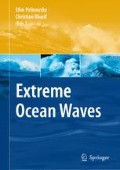Abstract
The Kadomtsev–Petviashvili equation, an extension of the Korteweg–de Vries equation in two horizontal dimensions, is here used to study the statistical properties of random shallow water waves in constant depth for crossing sea states. Numerical simulations indicate that the interaction of two crossing wave trains generates steep and high amplitude peaks, thus enhancing the deviation of the surface elevation from the Gaussian statistics. The analysis of the skewness and the kurtosis shows that the statistical properties depend on the angle between the two wave trains.
Access this chapter
Tax calculation will be finalised at checkout
Purchases are for personal use only
Preview
Unable to display preview. Download preview PDF.
References
Battjes JA (1974) Surf similarity. In: Proceedings of the 14th international conference on coastal engineering, Copenhagen, Denmark
Bitner-Gregersen E, Eknes M (2001) Ship accidents due to bad weather. Technical Report 2001-1330, Det Norske Veritas
Demirbilek Z, Vincent L (2002) Water wave mechanics. In: Demirbilek Z, Vincent L (eds) Coastal engineering manual, Part II. Hydrodynamics, chap. II-1, Engineer manual 1110-2-1100. US Army Corps of Engineers, Washington, DC
Donelan M, Magnusson AK (2005) The role of meteorological focusing in generating rogue wave conditions. In: Proceedings of the 14th Aha Huliko a Hawaiian winter workshop, University of Hawaii at Manoa, USA, 24–28 January 2005
Fornberg B, Whitham GB (1978) A numerical and theoretical study of certain nonlinear wave phenomena. Philos Trans R Soc Lond Ser A 289:373–404
Forristall GZ (2000) Wave crests distributions: Observations and second-order theory. J Phys Ocean 30:1931–1943
Goda Y (2000) Random seas and design on marine structures. Advanced Series on Ocean engineering, vol. 15. World Scientific, Singapore
Greenslade DJM (2001) A wave modelling study of the 1998 sydney to hobart yacht race. Aust Met Mag 50:53–63
Hauser D, Kahma KK, Krogstad HE, Lehner S, Monbaliu J, Wyatt LW (eds) (2005) Measuring and analysing the directional spectrum of ocean waves. Cost Office, Brussels
Herbers THC, Orzech M, Elgar S, Guza RT (2007) Shoaling transformation of wave frequency-directional spectra. J Geophys Res 108(C1):doi:10.1029/2001JC001304
Janssen TT, Herbers THC, Battjes JA (2006) Generalized evolution equations for nonlinear surface gravity waves over two-dimensional topography. J Fluid Mech 552:393–418
Johnson RS (1997) A modern introduction to the mathematical theory of water waves. Cambridge University, Cambridge
Kadomtsev BB, Petviashvili VI (1970) On the stability of solitary waves in weakly dispersive media. Sov Phys Doklady 15:539–541
Komen GJ, Cavaleri L, Donelan M, Hasselmann K, Hasselmann H, Janssen PAEM (1994) Dynamics and modeling of ocean waves. Cambridge University, Cambridge
Lehner S, Günther H, Rosenthal W (2005) Extreme wave observations from radar data sets. In: Ocean waves measurements and analysis, Fifth international symposium WAVES 2005, Madrid, Spain, 3–7 July 2005, paper 69
Longuet-Higgins MS (1952) On the statistical distribution of the heights of sea waves. J Mar Res 11:1245–1266
Miles JW (1977a) Diffraction of solitary waves. Z Ang Math 28:889–902
Miles JW (1977b) Note on solitary wave on a slowly varying channel. J Fluid Mech 80:149–152
Onorato M, Osborne AR, Serio M (2006) Modulation instability in crossing sea states: A possible mechanism for the formation of freak waves. Phys Rev Lett 96:014503
Osborne AR, Petti M (1994) Laboratory-generated, shallow-water surface waves: analysis using the periodic, inverse scattering transform. Phys Fluids 6(5):1727–1744
Pelinovsky E, Sergeeva A (2006) Numerical modeling of the kdv random wave field. Eur J Mech B Fluids 25:425–434
Peterson P, Soomere T, Engelbrecht J, van Groesen E (2003) Soliton interaction as a possible model for extreme waves in shallow water. Nonlinear Proc Geophys 10:503–510
Segur H, Finkel A (1985) An analytical model of periodic waves in shallow water. Stud Appl Math 73:183–220
Shukla PK, Kaurakis I, Eliasson B, Marklund M, Stenflo L (2006) Instability and evolution of nonlinearly interacting water waves. Phys Rev Lett 97:094501
Soomere T, Engelbrecht J (2005) Extreme elevation and slopes of interacting solitons in shallow water. Wave Motion 41:179–192
Soomere T, Engelbrecht J (2006) Weakly two-dimensional interaction of solitons in shallow water. Eur J Mech B Fluids 25:636–648
Tanaka M (2001) A method of studying nonlinear random field of surface gravity waves by direct numerical simulations. Fluid Dyn Res 28:41–60
Tayfun AM (1981) Distribution of crest-to-trough wave heights. J Waterw Port C Ocean Eng 107(3):149–158
Tayfun MA (1980) Narrow-band nonlinear sea waves. J Geophys Res 85(C3):1548–1552
Toffoli A, Lefèvre JM, Bitner-Gregersen E, Monbaliu J (2006a) Towards the identification of warning criteria: Analysis of a ship accident database. Appl Ocean Res 27:281–291
Toffoli A, Onorato M, Monbaliu J (2006b) Wave statistics in unimodal and bimodal seas from a second-order model. Eur J Mech B Fluids 25:649–661
Ursell F (1953) The long wave paradox in the theory of gravity waves. Proc Camb Philos Soc 49:685–694
Author information
Authors and Affiliations
Editor information
Editors and Affiliations
Rights and permissions
Copyright information
© 2008 Springer Science + Business Media B.V.
About this chapter
Cite this chapter
Toffoli, A., Onorato, M., Osborne, A.R., Monbaliu, J. (2008). Non-Gaussian Properties of Shallow Water Waves in Crossing Seas. In: Pelinovsky, E., Kharif, C. (eds) Extreme Ocean Waves. Springer, Dordrecht. https://doi.org/10.1007/978-1-4020-8314-3_3
Download citation
DOI: https://doi.org/10.1007/978-1-4020-8314-3_3
Publisher Name: Springer, Dordrecht
Print ISBN: 978-1-4020-8313-6
Online ISBN: 978-1-4020-8314-3
eBook Packages: Earth and Environmental ScienceEarth and Environmental Science (R0)

